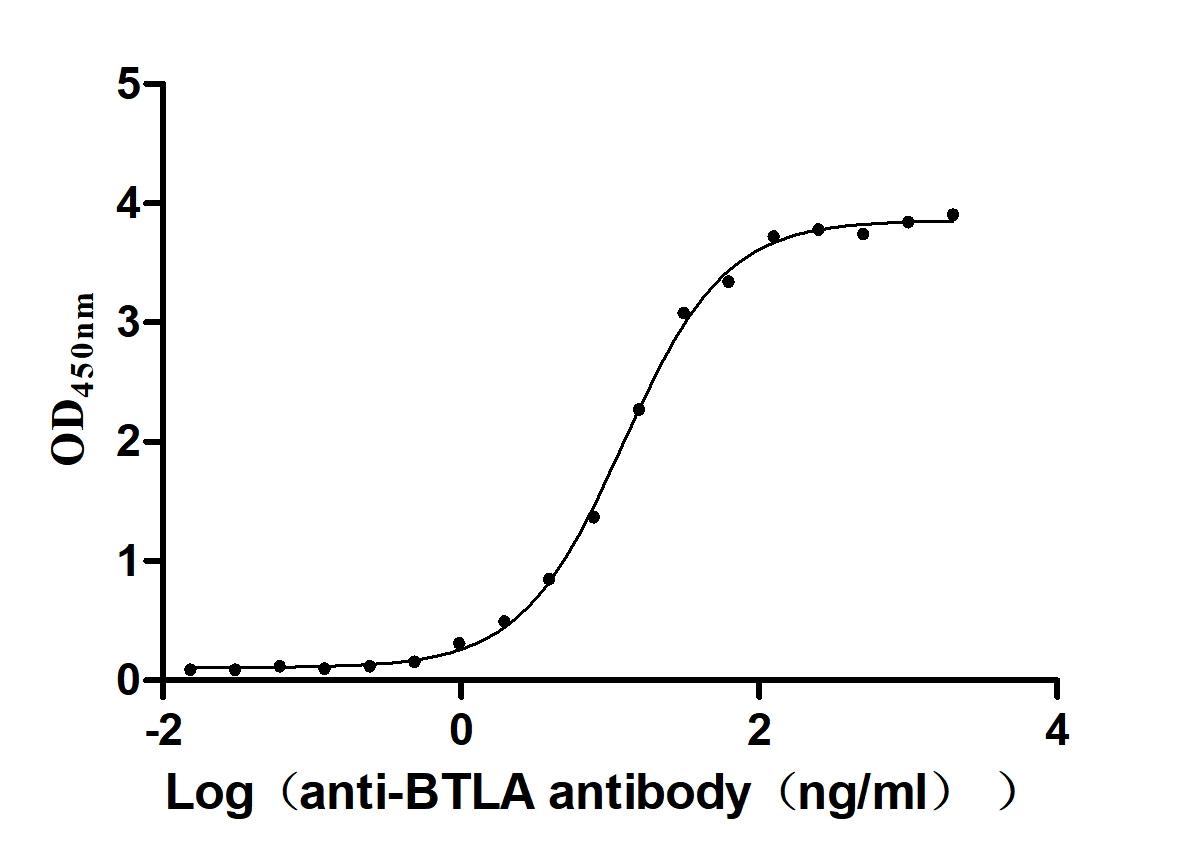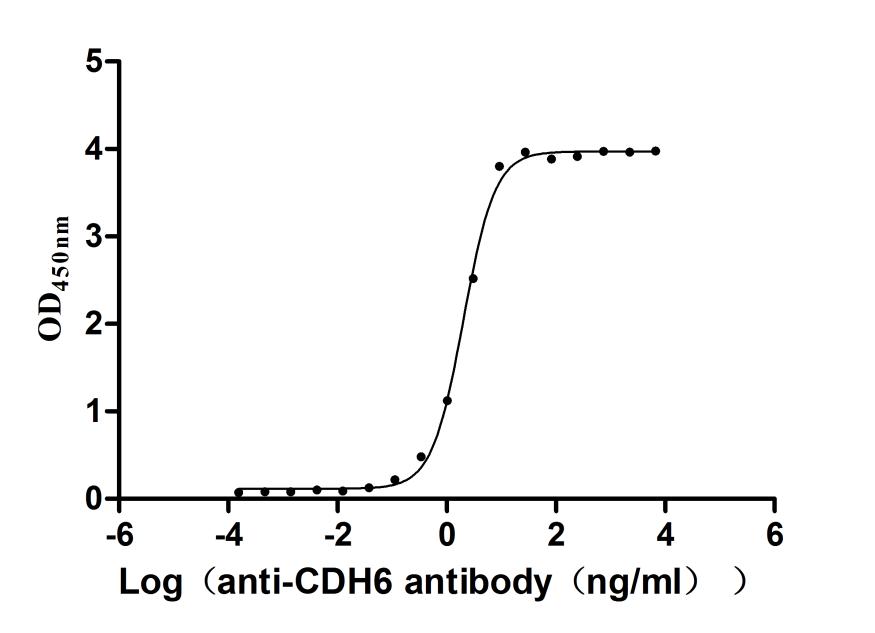Recombinant Rat Omega-3 fatty acid receptor 1 (O3far1)
-
中文名称:大鼠Ffar4重组蛋白
-
货号:CSB-CF639132RA
-
规格:
-
来源:in vitro E.coli expression system
-
其他:
产品详情
-
基因名:
-
Uniprot No.:
-
别名:Ffar4; Gpr120; O3far1; Free fatty acid receptor 4; G-protein coupled receptor 120; Omega-3 fatty acid receptor 1
-
种属:Rattus norvegicus (Rat)
-
蛋白长度:full length protein
-
表达区域:1-361
-
氨基酸序列MSPECAQTTGPGPSRTPDQVNRTHFPFFSDVKGDHRLVLSVLETTVLGLIFVVSLLGNVC ALVLVVRRRRRGATVSLVLNLFCADLLFTSAIPLVLVVRWTEAWLLGPVVCHLLFYVMTM SGSVTILTLAAVSLERMVCIVRLRRGLSGPGRRTQAALLAFIWGYSALAALPLCILFRVV PQRLPGGDQEIPICTLDWPNRIGEISWDVFFVTLNFLVPGLVIVISYSKILQITKASRKR LTLSLAYSESHQIRVSQQDYRLFRTLFLLMVSFFIMWSPIIITILLILIQNFRQDLVIWP SLFFWVVAFTFANSALNPILYNMSLFRSEWRKIFCCFFFPEKGAIFTETSIRRNDLSVIS T
Note: The complete sequence including tag sequence, target protein sequence and linker sequence could be provided upon request. -
蛋白标签:N-terminal 10xHis-tagged
-
产品提供形式:Liquid or Lyophilized powder
Note: We will preferentially ship the format that we have in stock, however, if you have any special requirement for the format, please remark your requirement when placing the order, we will prepare according to your demand. -
缓冲液:Lyophilized from Tris/PBS-based buffer, 6% Trehalose, pH 8.0
-
储存条件:Store at -20°C/-80°C upon receipt, aliquoting is necessary for mutiple use. Avoid repeated freeze-thaw cycles.
-
保质期:The shelf life is related to many factors, storage state, buffer ingredients, storage temperature and the stability of the protein itself.
Generally, the shelf life of liquid form is 6 months at -20°C/-80°C. The shelf life of lyophilized form is 12 months at -20°C/-80°C. -
货期:Basically, we can dispatch the products out in 1-3 working days after receiving your orders. Delivery time may differ from different purchasing way or location, please kindly consult your local distributors for specific delivery time.Note: All of our proteins are default shipped with normal blue ice packs, if you request to ship with dry ice, please communicate with us in advance and extra fees will be charged.
-
注意事项:Repeated freezing and thawing is not recommended. Store working aliquots at 4°C for up to one week.
-
Datasheet & COA:Please contact us to get it.
相关产品
靶点详情
-
功能:G-protein-coupled receptor for long-chain fatty acids (LCFAs) with a major role in adipogenesis, energy metabolism and inflammation. Signals via G-protein and beta-arrestin pathways. LCFAs sensing initiates activation of phosphoinositidase C-linked G proteins GNAQ and GNA11 (G(q)/G(11)), inducing a variety of cellular responses via second messenger pathways such as intracellular calcium mobilization, modulation of cyclic adenosine monophosphate (cAMP) production, and mitogen-activated protein kinases (MAPKs). After LCFAs binding, associates with beta-arrestin ARRB2 that acts as an adapter protein coupling the receptor to specific downstream signaling pathways, as well as mediating receptor endocytosis. In response to dietary fats, plays an important role in the regulation of adipocyte proliferation and differentiation. Acts as a receptor for omega-3 polyunsaturated fatty acids (PUFAs) at primary cilium of perivascular preadipocytes, initiating an adipogenic program via cAMP and CTCF-dependent chromatin remodeling that ultimately results in transcriptional activation of adipogenic genes and cell cycle entry. Induces differentiation of brown and beige adipocytes probably via autocrine and endocrine functions of FGF21 hormone. Contributes to the thermogenic activation of brown adipose tissue and the browning of white adipose tissue. Activates brown adipocytes by initiating intracellular calcium signaling leading to mitochondrial depolarization and fission, and overall increased mitochondrial respiration. Consequently stimulates fatty acid uptake and oxidation in mitochondria together with UCP1-mediated thermogenic respiration, eventually reducing fat mass. Regulates bi-potential differentiation of bone marrow mesenchymal stem cells toward osteoblasts or adipocytes likely by up-regulating distinct integrins. In response to dietary fats regulates hormone secretion and appetite. Stimulates GIP and GLP1 secretion from enteroendocrine cells as well as GCG secretion in pancreatic alpha cells, thereby playing a role in the regulation of blood glucose levels. Negatively regulates glucose-induced SST secretion in pancreatic delta cells. Mediates LCFAs inhibition of GHRL secretion, an appetite-controlling hormone. In taste buds, contributes to sensing of dietary fatty acids by the gustatory system. During the inflammatory response, promotes anti-inflammatory M2 macrophage differentiation in adipose tissue. Mediates the anti-inflammatory effects of omega-3 PUFAs via inhibition of NLRP3 inflammasome activation. In this pathway, interacts with adapter protein ARRB2 and inhibits the priming step triggered by Toll-like receptors (TLRs) at the level of TAK1 and TAB1. Further inhibits the activation step when ARRB2 directly associates with NLRP3, leading to inhibition of proinflammatory cytokine release. Mediates LCFAs anti-apoptotic effects.
-
基因功能参考文献:
- Data show that G protein-coupled receptor 120 protein (GPR120) appears strongly on interstitial cells and also on spermatogenic cells. PMID: 28192519
- GPR120 expression in beta-cells and GPR120-mediated insulinotropic effects are altered in obesity and diabetic states in distinct ways, and these alterations may be mediated by PPARgamma. PMID: 27980130
- demonstrated a GPR120-mediated novel anti-inflammatory pathway in specific intestinal epithelial cell types that could be of therapeutic relevance to intestinal inflammatory disorders PMID: 26791484
- results indicated that the beneficial metabolic role of DHA was attributed to its ability to regulate glucose via the GPR120-mediated AMPK pathway in the skeletal muscles PMID: 26134561
- These results suggest that GPR120 plays an important role in the cell motile activity induced by TPA in WB-F344 cells. PMID: 25380627
- These data shows a widespread expression of GPR120 in the gut epithelium and can not confirm a major role for GPR120 in the regulation of GLP-1 secretion. PMID: 24520357
- rat GPR120 is a G-protein-coupled receptor whose ligand is a free fatty acid, and it may play an important role in the FFA-associated physiological responses. PMID: 18320172
显示更多
收起更多
-
亚细胞定位:Cell membrane; Multi-pass membrane protein. Endosome membrane; Multi-pass membrane protein. Lysosome membrane; Multi-pass membrane protein. Cell projection, cilium membrane; Multi-pass membrane protein.
-
蛋白家族:G-protein coupled receptor 1 family
-
数据库链接:
KEGG: rno:294075
STRING: 10116.ENSRNOP00000032715
UniGene: Rn.82501
Most popular with customers
-
Recombinant Human Lymphotoxin-alpha (LTA) (Active)
Express system: Mammalian cell
Species: Homo sapiens (Human)
-
Recombinant Human Tumor-associated calcium signal transducer 2 (TACSTD2), partial (Active)
Express system: Mammalian cell
Species: Homo sapiens (Human)
-
Recombinant Human Oncostatin-M (OSM), partial (Active)
Express system: Mammalian cell
Species: Homo sapiens (Human)
-
Recombinant Human B- and T-lymphocyte attenuator(BTLA), partial (Active)
Express system: Mammalian cell
Species: Homo sapiens (Human)
-
Recombinant Mouse Cadherin-6(Cdh6),partial (Active)
Express system: Mammalian cell
Species: Mus musculus (Mouse)

















